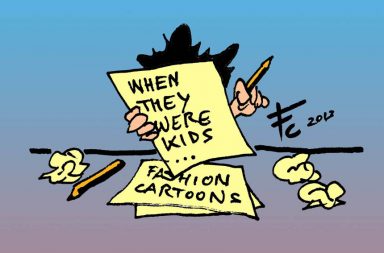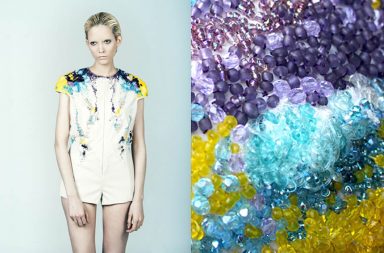For more than a decade, they’ve been supporting creative international talent. They’ve been the voice of young designers and have offered opportunities to show off their work in one of the most important windows into the fashion world. True to their founding principles, the team at International Talent Support is gearing up for their upcoming 13th edition later this year.
The adventure started when Barbara Franchin, the founder and heart of ITS, decided that it was time to support younger, more daring designs and designers. It hasn’t always been roses, however, but the passion that Barbara and her team have for the project has raised expectations ever higher at the international event. Every July since 2001, the eyes of fashion turn to Trieste (the Italian city in the northeast corner of the Adriatic) where they fall on the hustle and bustle of promising young talent just waiting to be discovered.
Over the years, scores of firms have joined in for the ride: Diesel, Yoox, YKK, Swatch, Swarosvski and Eyes On Talent. As the list grows, so to have the categories, from clothing to accessories, jewellery and even artwork. Thousands of portfolios from all parts of the world arrive to the ITS offices every year, and every year the number grows without fail.
At So Catchy! we’ve taken advantage of various finalists and ITS winners to fill our pages and now it’s Barbara Franchin’s turn. We had the pleasure of talking with her recently about the “ins and outs” of ITS.

Barbara Franchin
SO CATCHY!: What have these last 12 years of ITS been like?
BARBARA FRANCHIN: Wow. Well…Blood, sweat and tears. Tears of joy of course but also of anger and sadness. We started out with one competition and now we have four. We’ve viewed over 12,000 portfolios, selected more than 430 finalists, realised dreams and smashed others. We’ve given an identity to a town that would have never expected to host an event of this kind turning into the outpost of creativity research. It has been terribly exciting because we created a group of people that are now extremely qualified in their job, be it organisation, communication, multimedia, copywriting and much more. Our starting point was a 80 square meter office, now our work space is roughly 500 square meter packed with tons of material. We’ve had people like Isabella Blow, Raf Simons, Marina Abramovic, Franca Sozzani, Renzo Rosso and Viktor & Rolf in our juries. For at least half our existence we’ve been fighting for survival on the verge of failure. We’ve imposed a different style, we’ve made a statement. We’ve turned into some kind of benchmark. Young designers now look at us as “the place to be”, a sort of goal to aim to. Always unaware of what was happening, just focused on doing the job in what we considered the right way.
SC!: How has the work of young, new designers changed over the years?
BF: The arrival of the digital world which has replaced the analogic one has certainly changed things a lot. The naivety, freshness and romanticism we would usually find in the first years has turned in the later years in a higher consciousness of what is requested by the market and what is needed to secure their survival and find a job. In other words young designers recently have lost a few qualities they used to have (but there always are exceptions, of course) and gained others which are essential to make it in the business world, finding a great balance between creativity and a product which can be sold.

Design by Liz Ciokajlo
SC!: We’re living in a world of constant technological change that, without a doubt is affecting the way fashion is produced. How do you think fashion design will evolve as a result?
BF: I think there will be more and more micro-collections and most probably bespoke, personalised fashion and online sale will characterise always more the next historical period. Technology is bringing incredible innovations in the production and development of fashion, accessories and jewelry. We’ve been seeing for quite a number of years now the development of jewelry pieces using programs like Autocad or the like. 3D printing is an impressive new frontier which is becoming accessible for everyone. ITS has already seen in these last few years collections developed entirely through 3D printing, for example, Ana Rajcevic and Liz Ciokajlo. Now even fashion designers are experimenting a lot with is. Finalist Yuima Nakazato, who has always been quite a pioneer in the use of the latest technologies, has been developing flexible 3D printed bibs that combine numbers and images of human muscles for his latest collection for his 2014 collection.
These new technologies are bringing possibilities that were unthinkable in fashion only a few years ago, especially in shapes, materials used and preciseness of execution.
Moreover, “the internet of things” appears like the next big revolution and wearable technologies will be strongly involved. Computing systems in fabrics, internet-connected watches and much more will probably change our everyday life as we know it. Many of these things are already on the market and it is just the first prototypes. Stepping into a room, our body temperature through a chip in our fabric could regulate the cooling/warming of the room. Our gps position will provide important information for companies on our movements and interests…Slightly frightening, but certainly revolutionary…
SC!: On the other hand, more and more we’re seeing designers that are interested in responsible, sustainable fashion. Are we witnessing the birth of a movement that combines slow fashion with the eco-friendly world? What’s your opinion?
BF: My opinion is that we are still very far a really sustainable fashion. We’re just at the beginning of an eco-sustainable consciousness which I believe has to be imagined from a broader point of view. If we develop sustainable products in a non-sustainable way, we’re still far from the real goal. “Eco” stands for the whole process. It involves man, the machines involved, treatment of materials, waste of the production facilities, energy used for production which should be clean…We are certainly witnessing a historical change. As far as ITS is concerned, we are beginning to receive a considerable amount of projects based on a sustainable approach. For instance, among the ITS 2013 finalists we had the footwear projects of Liz Ciokajlo and Doyun Kim. Yet again, I would wish the whole circle – from development to production – to be entirely sustainable. It would involve a complete re-thinking of our society and I see great potential for new work possibilities both from a projectual and organisational point of view. I am a bit worried though that our society is not ready for such a pivotal change. It will involve stopping for a while, and investing more money, time and people. And I don’t think that companies really have this kind of social responsibility…For now, “eco” and “sustainable” are being used because people find it more and more appealing. But what happens next?

Shoes by Doyun Kim
SC!: Can you explain a bit about the process of pre-selecting and the selection of designers?
BF: Our deadline to enrol is always around the end of March. So from the moment we launch in January right down to March our offices are gradually flooded by portfolios. We start with a few rings of our doorbell and end in March with a constant ring and couriers delivering dozens of packages at a time. Each one has to be opened, checked, inserted in its own personal folder, re-checked on the computer….I am really simplifying here, but even before I lay my eyes on the actual portfolios the process is time-consuming and quite complicated. But it is the only way to properly receive and archive each one of them, giving every single project that arrives the importance it deserves.
The following step is me closed in my offices for roughly two weeks, going through each and every page of each and every portfolio arrived for each one of our competition fields…Some 1,300 projects, give or take. I respect every one of them, I step into their dreams with great respect. I smell, I touch, I try to feel what it meant for each one of them to collect all the material together and send it to me. I do not throw away anything. ANYTHING. We have every single portfolio we received, neatly stored in our ITS CREATIVE ARCHIVE. I do a first selection (if I have 1,000, I’ll narrow it down to, let’s say, 250?) in order to present to the jury which will arrive in the end of April a part of the projects. ALL portfolios are available for their viewing, if for instance they want to check more of the projects arrived from a certain country, or school. Then as said, the jurors arrive, and the selections are made…
ITS 2013 Teaser from ITS International Talent Support on Vimeo.
SC!: Can you tell our readers, many of whom are up-and-coming designers, what your organization is looking for as far as clothes, footwear and accessories are concerned? What does it take to be a winner, a finalist, or to even be chosen to participate in the International Talent Support?
BF: First of all, we select projects. We do not select schools, or nations. What is important for us is to see individuality. Projects have to be the expression of a very strong individuality, declined in a project which is conceptually strong or fabric/material-wise interesting. We are interested in projects that are capable of combining creativity with technical abilities in the realisation. We want to see the ability to tell the story of the project, draw it, demonstrating a fabric/material sensibility. These are certainly the characteristics we value the most during the selection. It is furthermore very important that the prototypes of the outfits/pieces are produced at a high level, since ITS is a showcase of creativity.

Accessories by Milko Boyarov
SC!: How many candidates apply each year? How much has it grown from the beginnings of the show 13 years ago? Has it been a steady increase with every new edition?
BF: As I said above we receive roughly 1,200 – 1,300 projects. Of course, compared to the beginning this number more than doubled and also because we’ve introduced more competition fields throughout the years. It hasn’t been necessarily a steady increase. It has always grown, some years more, some less. Quality has globally increased as have the nations and schools (650 from 80 countries).
SC!: What nationalities are most represented in the show? Are there any schools or universities that predominate the selection?
BF: This is a tricky question because it depends if you’re referring to the nationality of the students or of the schools they’ve studied in…We’ve certainly had lots of Japanese finalists, British, Belgians, South-Korean, Germans. And I would say that globally I have seen a predominance of English schools in the last few years. Though, using another saying, there’s always the exception that proves the rule.
SC!: Tell us a bit about the day to day at ITS. How big is your team? How do you organize your work? And a part from organizing the show and everything that is involved with that, do you seek out young designers in schools around the world?
BF: Wow, this really is a difficult question…I could talk for hours about this. I spend most of my days jumping from one topic to the other: budget handling, communication planning, documents approval, conference calls, email replies, project planning, talent searching, fund raising, meeting with potential partners, some laughing, a lot of yelling, a little crying… It involves a lot of creative thinking to approach so many different things in one single day, I can tell you that! And the list goes on, of course. Without my staff I would be lost of course. I picked each one of them for their own talent and of course I am like an orchestra conductor who knows the right way for each one to perform at their maximum. We rehearse and rehearse and rehearse AND rehearse to the point the conductor disappears during the ITS finals in July, and the orchestra knows exactly what to do even if I’m not there. In my spare time, I still travel to meet the designers in the schools though the digital era made it also possible for me to discover young talents also through the web. Though meeting them in person is an entirely different thing. I’ve travelled to Japan, India, Cuba, Iceland, the US, Brazil, Germany, France, Denmark, Slovenia, Austria, Spain, the UK to meet them…and I’ll travel more. A jewel can be found in the most unthinkable of places.
SC!: What do you think about the Spanish fashion world and designers like Leandro Cano or Anel Yaos?
BF: I’ve been always appreciating the work of talented Spanish designers. Leonardo Cano’s experimentations of shapes and volumes are wonderful and I love the way Anel Yaos is challenging the conventions of menswear. They both have strong signature styles. We’ve had terrific Spanish talents at ITS, like Corina Gonzalez who designed for Diesel Black Gold for several years, Natalia Culebras Cruz who is senior designer for Dior Homme, the amazing Amai Rodriguez who has her own brand…Spanish designers have a very particular kind of creativity which I really love.
SC!: What’s the key to the success of your organization?
BF: A military organisation blended with a necessity to do our job dictated by an infinite passion in what we do. Our ambition since the very beginning wasn’t to make money, but to raise as much money as possible to make this happen providing us with the means for rightful survival. Equally important is a very well selected and very well trained team of people that works with me as a family.
SC!: What do you expect from the next edition ITS 2014?
BF: I expect to be blown away by the amount of ideas and creativity that exists in the world…
Photos courtesy of:
International Talent Support
Nelly Hoffman: Pierre Marchal, Maxence Boulart Cardon, Daniele Milvio
Milko Boyravo: Simone Falcetta, Swarovski Elements Project, ITS 2013
Cat Potter: Fiona Lewis
Keren Yaar: Sasha Prilutzki and Lee Agmon
Mala Siamptani: Matt Jackson and Charlotte Lucca
Translated by Michael Padilla




